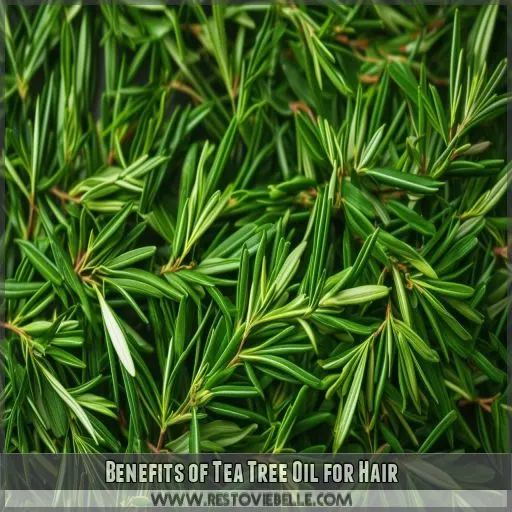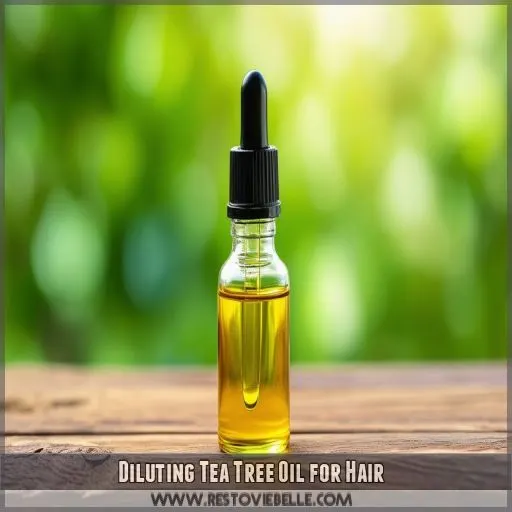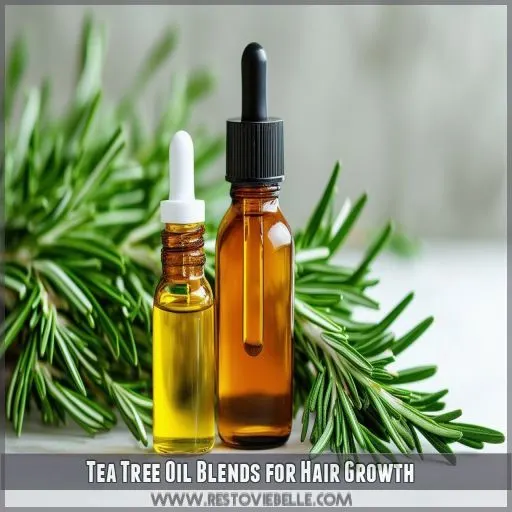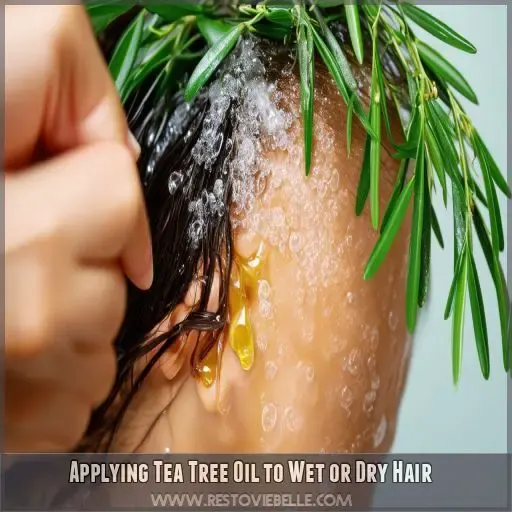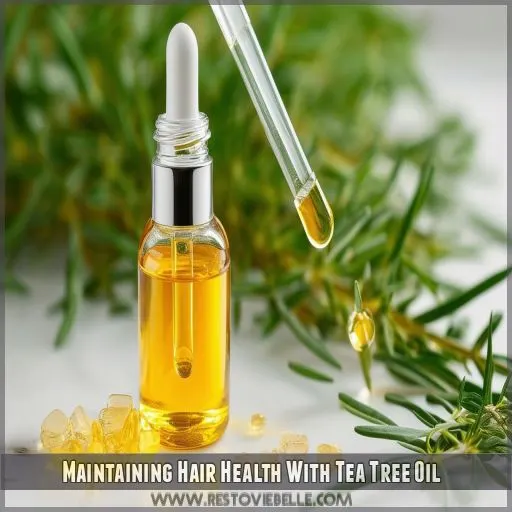This site is supported by our readers. We may earn a commission, at no cost to you, if you purchase through links.
 The essential oil, originating from the leaves of Melaleuca alternifolia, boasts incredibly antimicrobial and anti-inflammatory properties that make it a hair care powerhouse.
The essential oil, originating from the leaves of Melaleuca alternifolia, boasts incredibly antimicrobial and anti-inflammatory properties that make it a hair care powerhouse.
Learn how to use tea tree oil to grow your hair, reduce hair loss, kill dandruff, and enhance shine.
Learn how to apply this oil and combine it best for optimal results to keep your hair firm and lustrous
Table Of Contents
- Key Takeaways
- How to Use Tea Tree Oil for Hair Growth?
- Understanding Tea Tree Oil
- Benefits of Tea Tree Oil for Hair
- Diluting Tea Tree Oil for Hair
- Tea Tree Oil Blends for Hair Growth
- Applying Tea Tree Oil to Wet or Dry Hair
- Timing Tea Tree Oil Application
- Potential Risks and Warnings
- Maintaining Hair Health With Tea Tree Oil
- Frequently Asked Questions (FAQs)
- Can I apply tea tree oil directly on hair?
- Does tea tree oil make your hair grow faster?
- Do you put tea tree oil in wet or dry hair?
- Do you put tea tree oil in your hair before or after shampoo?
- Is tea tree oil safe for color-treated hair?
- Can tea tree oil be used on childrens hair?
- How often should tea tree oil be used for dandruff?
- What concentration of tea tree oil is effective in shampoo?
- Can tea tree oil be mixed with other essential oils for hair benefits?
- Conclusion
Key Takeaways
- Tea tree oil is a hair growth superhero, thanks to its ability to fight dandruff, reduce inflammation, and promote circulation.
- Add a few drops of tea tree oil to your shampoo or conditioner, and let it work its magic for a few minutes before rinsing.
- You can also apply tea tree oil directly to your scalp, but be sure to dilute it with a carrier oil like coconut or almond oil first.
- Be patient and consistent with your tea tree oil treatments, and you’ll be amazed at how much healthier and thicker your hair looks and feels
How to Use Tea Tree Oil for Hair Growth?
You can use tea tree oil to support hair growth by diluting it in a carrier oil, such as coconut or jojoba, in a 1:10 ratio. Do a patch test to observe any irritation.
Massage the blend into your scalp and hair; leave it on for up to one hour, then shampoo. Use up to three times a week.
Blending with oils like lavender or rosemary enhances benefits. You can apply it either before shampooing to cleanse the scalp or after to seal in benefits. Remember, dilute properly to avoid irritation.
For more tips and tricks, stick around
Understanding Tea Tree Oil
Tea tree oil, derived from the Melaleuca alternifolia plant, is renowned for its potent antimicrobial and anti-inflammatory properties, making it a common ingredient in hair care products. Its benefits include promoting hair growth, reducing hair fall, and combating oily hair
Derived From the Melaleuca Alternifolia Plant
Tea tree oil is derived from the Melaleuca alternifolia plant and has several benefits about both hair and scalp health. In addition, it improves scalp health, supporting long-term hair growth. Such versatility makes applying tea trees even more effective in improving your overall hair health.
Known for Its Antimicrobial and Anti-inflammatory Properties
Tea tree oil’s antimicrobial, anti-inflammatory, antibacterial, and antifungal properties make it a potent agent for hair and scalp health. By combating scalp eczema, reducing inflammation, and addressing fungal infections, it paves the way for healthier hair growth. These properties have made it a staple in medicinal uses for maintaining strong, clean hair
Commonly Used in Hair Care Products
You’ll find tea tree oil in many hair care products because it supports various hair types and textures. Here’s why it’s so popular:
- Shampoo with tea tree oil: Reduces dandruff.
- Carrier oil blends: Nourish and improve hair porosity.
- Leave-in treatments: Combat oily hair and enhance shine.
- Fragrance oil replacements: Keeps products natural
Benefits of Tea Tree Oil for Hair
Tea tree oil is good for hair growth and may even additionally prevent hair fall by regulating scalp health and inflammation. It also fights well with dandruff and relieves dry scalp, enhances shine in hair, or contributes to its vitality.
Promotes Hair Growth
When you use tea tree scalp treatment, the active component, terpinen-4-ol, works wonders. It improves blood flow to your follicles, promoting hair growth and reducing hirsutism symptoms. Regular use of tea tree oil hair products, like tea tree oil shampoo or mask, can transform your hair. Enjoy healthier, stronger hair with tea tree oil!
Reduces Hair Fall
Tea tree oil consumption promotes growth and significantly reduces hair fall. Its antimicrobial properties are helpful in treating dandruff and, hence, soothe the scalp with problems that may cause hair loss.
Massages, once a week, using diluted tea tree oil, improve shine and combat dryness for healthier and stronger hair.
If there’s an underlying condition of sensitive skin or contact dermatitis, test it before use
Combats Oily Hair
Tea tree oil combats oily hair by balancing your scalp’s sebum production. It penetrates your hair follicles, clearing blockages and promoting a healthier scalp. This helps reduce excessive oiliness and leaves your hair feeling fresh. Just dilute it with vegetable oil, apply as a hair mask, and rinse with distilled water. This simple remedy makes oily hair manageable
Fights Dandruff and Dry Scalp
Tea tree oil is a fantastic dandruff treatment, known for its ability to combat dry and itchy scalp. Its antifungal properties target the root cause of dandruff, reducing scalp irritation effectively. By incorporating tea tree oil into your routine, you can fight those persistent flakes and keep your scalp healthy and itch-free
Enhances Hair Shine
In addition to fighting dandruff and promoting hair growth, tea tree oil enhances hair shine. It balances the scalp’s oil production, which leaves your hair looking sleek and glossy. By incorporating tea tree oil into your hair care routine, you’re not just improving scalp health, but also adding a brilliant, healthy sheen to your locks
Diluting Tea Tree Oil for Hair
In using tea tree oil for hair, it’s important always to dilute it with some carrier oil; otherwise, it can irritate. Apply this mixture onto your scalp and the hair, leave it on for an hour before rinsing off, and use it up to three times a week.
Test on a Small Skin Patch Before Regular Use
Always conduct a patch test on a small area of your skin before applying tea tree oil to your hair to check for allergic reactions.
The essential oil must be highly diluted with carrier oils like coconut or almond oil at a ratio of 1:10. In this case, it won’t cause damage, and the risk of irritation or skin allergies is relatively minimal.
Apply and wait for discomfort before regular use
Apply to Scalp and Hair
To apply tea tree oil to your scalp and hair, mix it with a bit of carrier oil. Apply this oil by the following technique:
- Use a small amount of the diluted mixture.
Massage into your scalp gently.
- Work through your hair to ensure even coverage.
- Use it as a hair mask.
- Leave-in application for added benefits.
Leave in for Up to an Hour
Leave the diluted tea tree oil mixture (1:10 ratio) on your scalp and hair for up to an hour. This provides ample time for the oil to penetrate and work its magic. Consider your scalp sensitivity, and if necessary, adjust the duration. For those with low sensitivity, overnight application can be beneficial, depending on your hair type
Use Up to Three Times Per Week
Use your mixture of tea trees up to three times a week for best results. Combine tea tree oil with carrier oil.
Do a patch test, then apply this to your scalp. This allows the promotion of hair growth without much possible irritation.
Regular application is made to the scalps to ensure that all benefits are sucked in and not overwhelm the hair and scalp
Tea Tree Oil Blends for Hair Growth
You can enhance the benefits of tea tree oil for hair growth by blending it with lavender oil, which promotes hair growth, or rosemary oil, known for thickening and strengthening hair. Simply mix these essential oils with a carrier oil before applying to your scalp for an effective hair growth treatment
Lavender Oil: Promotes Hair Growth
Blend tea tree with lavender oil and turbocharge your hair growth. It improves blood circulation and’s important for healthy follicles, while tea tree oil cleans out stuffy residue on the scalp. Combine oils with a carrier oil to apply it on the scalp and enhance the growth of your hair. Apply this blend a maximum of thrice a week.
Rosemary Oil: Thickens and Strengthens Hair
Rosemary oil is a powerful ally for thicker, stronger hair. When blended with a carrier oil like coconut or jojoba, it can:
- Stimulate hair follicles to promote growth.
- Improve circulation to nourish the scalp.
- Fortify strands, reducing breakage and shedding.
Dilute rosemary oil at a 1:10 ratio with your carrier oil of choice for best results. Massage this blend into your scalp and hair regularly for healthier, more vibrant locks
Blend With Carrier Oil
Always mix essential oils, especially tea tree oil, with a carrier oil for maximum benefits and safety.
Some commonly used carrier oils include coconut oil, olive oil, and jojoba oil.
Apply 1:10 dilution ratios for the best effect.
Apply this mixture to your scalp up to three times a week.
Do remember to conduct the skin patch test first to check any sensitivity of your scalp
Applying Tea Tree Oil to Wet or Dry Hair
When applying tea tree oil to your hair, you may wonder if it’s best used to wet or dry hair. The thing is that both ways can be efficient depending on what your needs and preferences are. Here’s a quick guide to help you decide.
- Wet Hair Application: Mix the tea tree oil with carrier oil and massage it into the scalp after showering. This is a sure way of it being applied evenly and absorbed immediately.
- Dry Hair Application: Mix some carrier oil, like almond or coconut oil, with a few drops of tea tree oil. Apply it directly to your scalp and leave it on for up to an hour before washing.
- Tea Tree Concentration: Be sure to provide a good dilution of about 1:10 for non-irritating contact with the scalp.
- Application Frequency: Use 2-3 times a week for best results; suitable for all hair types.
Timing Tea Tree Oil Application
You can use tea tree oil either before or after shampooing. Applying it before shampooing helps cleanse your scalp, while applying it afterward seals in the benefits
Can Be Used Before or After Shampooing
You can apply tea tree oil before or after shampooing. When used beforehand, it preps your scalp, while post-shampooing helps lock in its benefits. Dilute with a carrier oil, and use sparingly to begin with. Experiment with timing to suit your routine, maximizing the oil’s potency. Balance frequency to avoid overuse, typically three times weekly
Applying Before Shampooing Can Help Cleanse the Scalp
Applying tea tree oil before shampooing can help cleanse your scalp. Here’s how:
- Dilution: Mix tea tree oil with a carrier oil.
- Application: Gently massage the mixture into your scalp.
- Timing: Leave it for 15-20 minutes.
- Benefits: Helps reduce dandruff, unclogs hair follicles, and harnesses tea tree oil’s hair growth potential
Applying After Shampooing Can Help Seal in the Benefits
After shampooing, tea tree oil application helps seal in the benefits by locking in moisture and nutrients. It’s the best method for maintaining a healthy scalp and promoting hair growth. Simply dilute the oil with a carrier oil, apply it lightly to your scalp, and let it dry naturally. This approach enhances shine and combats dandruff efficiently
Potential Risks and Warnings
When using tea tree oil for hair growth, always dilute it with a carrier oil to avoid skin irritation. Don’t ingest it, and be aware that it may cause skin reactions in some individuals
Dilute With Carrier Oil Before Use
Always mix the tea tree oil with another oil, which is called a carrier oil, not to irritate your skin.
For a 1:10 ratio, one drop of the tea tree oil should be mixed with ten drops of whichever carrier oil you like.
Some of these are almond, coconut, or olive.
Massage it into your scalp thrice a week for safety and efficacy
Avoid Swallowing or Ingesting
Avoid swallowing or ingesting tea tree oil—it can be toxic. Risks include:
- Tea tree oil ingestion: This can lead to severe symptoms like confusion, loss of coordination, and even coma.
- Tea tree oil toxicity: Symptoms might include systemic reactions.
- Tea tree oil poisoning: Small amounts can be harmful.
- Tea tree oil overdose: Always dilute and use topically to avoid adverse effects
May Cause Skin Irritation in Some Individuals
Tea tree oil may cause skin irritation, particularly for those with sensitive skin or allergies. Always do a skin patch test before use. Dilute the oil with a carrier oil to minimize risks. Potential allergic reactions include itching, rash, and swelling. Use the table below to evaluate and address symptoms.
| Symptom | Action | Severity Level |
|---|---|---|
| Itching | Discontinue use, apply cool compress | Mild |
| Rash | Wash area, apply hydrocortisone | Moderate |
| Swelling | Seek medical attention | Severe |
Maintaining Hair Health With Tea Tree Oil
Maintaining hair health with tea tree oil requires consistent application and careful consideration. To reap its benefits, try incorporating tea tree oil into your hair care routine. Consistent use can help you achieve a healthier scalp, reduce dandruff, and promote hair growth. Here are some tips:
- Regular Use: Apply tea tree oil diluted with a carrier oil two to three times weekly to maintain scalp health.
- Targeted Application: Focus on problem areas, such as the scalp, to combat dandruff and promote hair shine.
- Combine with Other Oils: Mix tea tree oil with lavender or rosemary oil to enhance its effects on hair growth and reduce hair loss.
Use these tips to keep your scalp and hair in top condition
Frequently Asked Questions (FAQs)
Can I apply tea tree oil directly on hair?
You shouldn’t apply tea tree oil explicitly to your hair. Always mix it with a carrier oil, like almond or coconut oil, in a ratio of 1 part to 10 parts, lest irritation happens and the benefit reaching the hair is optimum.
Does tea tree oil make your hair grow faster?
Tea tree oil won’t make your hair grow faster overnight, but it can do something about creating a healthy environment on the scalp, where it reduces dandruff and inflammation. In return, this fosters perfect hair growth conditions over time.
Do you put tea tree oil in wet or dry hair?
Apply the tea tree oil, diluted with a carrier oil, onto dry hair for maximum absorption. This will help the oil to get to the scalp much better and promote hair growth, as well as treat many common ailments of the scalp.
Do you put tea tree oil in your hair before or after shampoo?
Apply the tea tree oil to your hair before shampooing. Mix a few drops with a carrier oil, massage into the scalp, and let it work for 15-30 minutes before rinsing and shampooing properly.
Is tea tree oil safe for color-treated hair?
Color-treated hair can be danced with safely using tea tree oil, but keep it diluted with some carrier oil to prevent stripping the color. Always test on a small patch first to ensure your vibrant hues stay untouched.
Can tea tree oil be used on childrens hair?
Yes, you can use tea tree oil in children’s hair. Ensure it’s well diluted with a carrier oil to avoid irritations, and always conduct a patch test to see any signs of allergy or sensitivity before its complete application.
How often should tea tree oil be used for dandruff?
Studies show a 41% reduction in dandruff with 5% tea tree oil shampoo. For effective results, use this shampoo daily, lathering for 3 minutes, for 4 weeks. This regimen helps maintain a dandruff-free, healthy scalp
What concentration of tea tree oil is effective in shampoo?
A concentration of tea tree oil effective in shampoo against dandruff is 5%. This type of concentration can cause a recognizable reduction of dandruff by using it daily. Massaging for 3 minutes over 4 weeks.
Can tea tree oil be mixed with other essential oils for hair benefits?
Mix tea tree oil with lavender or rosemary oil and a carrier oil. Like combining powers, they enhance each other’s benefits for hair, promoting growth, improving strength, and soothing the scalp
Conclusion
Nature in a bottle—tea tree oil can be your hair’s best buddy. Adding this magic potion to your haircare regime will help in everything from stimulating hair growth to fighting off dandruff.
Be it shiny locks or a healthy scalp, knowing how to use tea tree oil for hair growth is essential. Embrace the natural goodness and let it bloom into fantastic results for your hair with this remarkable essential oil


